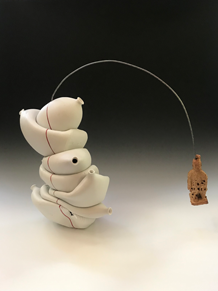 |
This artist talk + demo runs from 10 am to 3pm with an hour lunch break in between. Plenty of food will be provided. Jenchi will be answering questions throughout the whole event so come prepared with things to ask!
Jenchi will be demonstrating her master throwing techniques, including double-rib throwing, making large sectional forms, slip decoration, sodium silicate application, and much more!
Saturday, April 18th, 2020
from 10am to 3pm.
MEMBER PRICE: $75*
*(the price difference will be refunded)
NON-MEMBER PRICE: $90
REGISTER
|
JENCHI WU
Jenchi Wu is a ceramic artist/educator that was born and raised in Taiwan. She moved to California in 1990 to continue her studies. She took her first ceramics class in 1994, received her MFA from California State University Los Angeles in 2005, and has been working with clay ever since. Jenchi is now the head of the ceramics department at Ventura College and continues to produce and exhibit her work all over the world. She has also taught at various institutions including Pasadena City College, East Los Angeles College, and Los Angeles Valley College. Wu’s process allows the clay to take on new forms – “the relationship between the artist’s hands and the art work is in constant flux.”
Artist Statement
I never imagined that I would become an artist who works with clay. My first
recollection of clay was at my late-grandparents' hardware store in Taipei. The
store carried everything from pots and pans, to screws and nails. That was my first
time seeing bundles and bundles of ceramics bowls carried on a mover’s shoulder,
being moved matter-of-factly into my grandpa's store. Because of this unique
circumstance, I never got into trouble when I accidentally broke a bowl or two, so
never grew up feeling ceramics were precious or had to be coddled. My love with
ceramics began there.
The action or implication of breaking became a tradition for many cultures – in the US, we give encouragement by saying "break a leg." Breaking glasses during
Jewish weddings can represent both joy and sadness. The Finnish also have a
tradition of breaking plates, with the number of broken shards representing the
number of children the newlyweds can expect to have. A German tradition is for
guests to break plates for good luck before entering the bride's house. The list goes
on with similar traditions in Bulgaria, Czechoslovakia, Greece and others. Once
the functional ceramics are broken, the utilitarian purpose takes on different
meanings.
A perfect clay vase that is dropped and squashed during its plastic stage takes on a
completely new form. That physical impact on clay is what intrigues me. My work
explores various states of impact and breaking. Through repetition and
deconstruction, I allow the clay to take on new forms. The moment of impact is
then fired and captured in the ceramic, with the result showing the conversation
between the artist’s hands and the clay which is constantly in flux.
|
